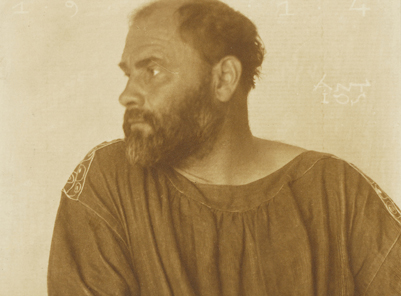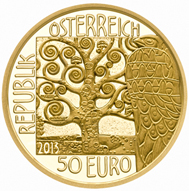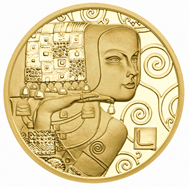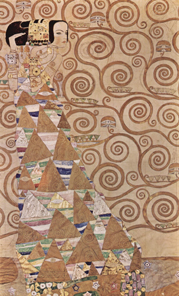February 28, 2013 – On February 27, 2013 the Austrian Mint has issued the second coin in its five gold coin series celebrating Gustav Klimt, a key painter of the art nouveau period whose art is easily recognized and admired around the world.
Klimt was born in Austria in 1862 and very early on his artistic gift became evident. He was classically trained, and began his career by painting murals and ceilings in large public buildings. His great love and primary subject, however, was the female form.
Photo portrait of Gustav Klimt by Josef Anton Trcka, 1914.
Gustav Klimt was one of the founding members of the Vienna Secession, “Ver Sacrum”, art movement that officially existed from 1897-1905 – a movement funded by the government that presented young non-conventional artists. Many very well known artists were also members of this group such as Otto Wagner, Koloman Moser, Josef Hoffmann and Egon Schiele, to name but a few.
The last public commission completed by Klimt was for three murals for the University of Vienna, featuring Philosophy, Medicine and Jurisprudence. Done in very much his radical style of thought-provoking eroticism, these paintings, when revealed to the public, generated an outcry that was exceptionally strong. With many people having labelled them “pornographic”, these paintings were never used for their original intent in the Great Hall of the University. Sadly, they were destroyed at the end of the Second World War.
Klimt tended to work from his home, enjoying a relaxed lifestyle wearing robes and sandals, devoted to his art and life style. His life companion was Emilie Floege whom he met in 1890. Klimt’s love of the female form was not exclusive to his art but to the many relationships he enjoyed. He is known to have fathered 14 children. He died in 1918, at the age of 56, from a heart attack.
From about 1885 onward Klimt enjoyed his “Golden Period”, reflecting his critical success and acclaim, as well as his regular use of gold leaf in his paintings. His fame brought many patrons to him and he was able to be selective about the commissions he accepted. Klimt received the Golden Order of Merit from Emperor Francis Josef I in 1888, for the murals he painted in the Palace Theatre. Klimt’s painting entitled “Philosophy” won gold at the Paris Exhibitions of 1900, and “Death and Life” received first prize at the world exhibition in Rome in 1915. Several of Klimt’s paintings have brought some of the highest prices ever paid for art in the world.
The obverse, featuring the “Tree of Life” from the Stoclet frieze, is framed by a square of the artist’s canvas, and was conceptualized by the mint’s chief engraver, Thomas Pesendorfer. The tree is made up of many fine swirls and mosaic-like pieces commonly found in the art of Klimt. To the right of the Tree of Life symbolizing The Eye of Horus, and interpreted by Klimt in the form of the falcon, a symbol of power of the Egyptian Pharos. Also on this side appears the country of issue, “Republik Oesterreich” or Republic of Austria, the face value of 50 euros, and the year of issue, 2013.
The reverse features a portion of the frieze showing the head of a woman anxiously looking to the right, which is known as “Expectation.”
The scarf on her head has a very intricate pattern of geometric square-like shapes. Her hand is held in a pose found commonly in Egyptian paintings. Her wrist has a beautifully intricate armband, while more jewels and geometric shapes and swirls can be seen in her clothing. The reverse of the coin was conceived and engraved by mint engraver Herbert Waehner.
Draft of the panels in the Palais Stoclet in Brussels, detail: The Expectation, 1905-1909. Source: Wikipedia.
The Stoclet frieze was a special commission that Gustav Klimt received from a wealthy industrialist of Brussels, Belgium, Adolphe Stoclet. Stoclet was an avid art collector who commissioned the architect Josef Hoffman (also world famous because of his key role in the art nouveau movement of Vienna, along with Klimt.) Klimt was commissioned to create a masterpiece in the dining room. The wealth and appreciation of the art nouveau movement by Stoclet meant that no boundaries were placed on the art nor on the budget of this now world heritage site, The Stoclet House in Brussels. Hence for the artists “The Stoclet House”, (which also includes works by yet another secessionist of Vienna Koloman Moser) were able to produce the most complete work or “Gesamtwerk” of the Vienna Secessionist or Art Nouveau period.
Klimt completed two intricate paintings on the dining room walls, one of which was the well-known “Expectation” featured on this gold coin. The “Expectation” is that of the young lady, who is a dancer, anxiously looking to the right, and yearning for love. (Another part of the frieze completes the search for love depicting a young couple embracing, and therefore is known as “Fulfillment.”) Klimt stated publically that the Stoclet frieze was his ultimate decorative work.
Gustav Klimt was inspired by many cultures of history. Certainly Byzantine mosaics greatly inspired Klimt and hence appear in many of his works. As well, forms and shapes from very early times such as ancient Egypt, right up to more recent periods of his life all influenced his art during his life.
The very complex and meaningful “Tree of Life” is symbolic of our roots deep in the ground, stretching up to the sky and the heavens. The Klimt “Tree of Life” bears both flowers and fruit and thereby symbolically includes both women and men, on their own, as well as together – bearing fruit. Hence the “Expectation” symbolizes the search for love. Scholars have for many years studied the Klimt tree to try and learn all of its secrets which are so pertinent to many cultures and religions.
The gold coins of this series illustrate the importance of women in Gustav Klimt’s artistic life. The coins present his work in a manner similar to an exhibition. Each of the coins will have another letter of his name K-L-I-M-T worked into the design – so that once the series is complete his last name will become part of the signature of the 5 coin series.
- 2012 Adele Bloch Bauer: letter K
- 2013 “Expectation”: letter L
- 2014 “Judith II”: Letter I
- 2015 Hygieia from the “Faculty Paintings” of the University of Vienna: letter M
- 2016 “The Kiss”: letter T
The new coin is struck in 986 fine gold to a maximum mintage of 30,000 pieces in proof quality only. The diameter of the coin is 22mm and it contains 10 grams of fine gold. Each coin is packed in an attractive box with a numbered certificate of authenticity, which provides detailed background and technical information about the quality and design of the coin.
A beautiful wooden collection case for the whole series, “Klimt and his Women”, may be purchased separately. It contains a booklet explaining the whole series.
More information about this and other coins are available on the website of the Austrian Mint.
We reported on this new series here.
Until now you can visit Klimt’s studio in Vienna which is managed by the Klimt Memorial Society. You may like to take a look on it here.
Many information on Klimt and his whole oeuvre are available to view in the Klimt Online Museum.







